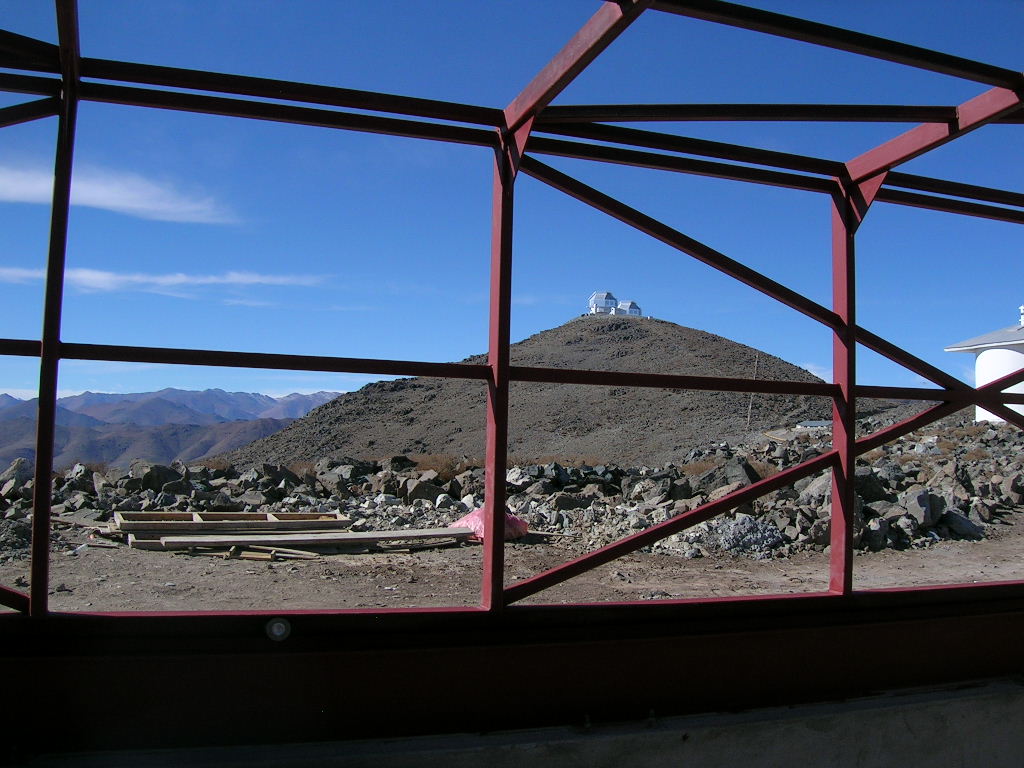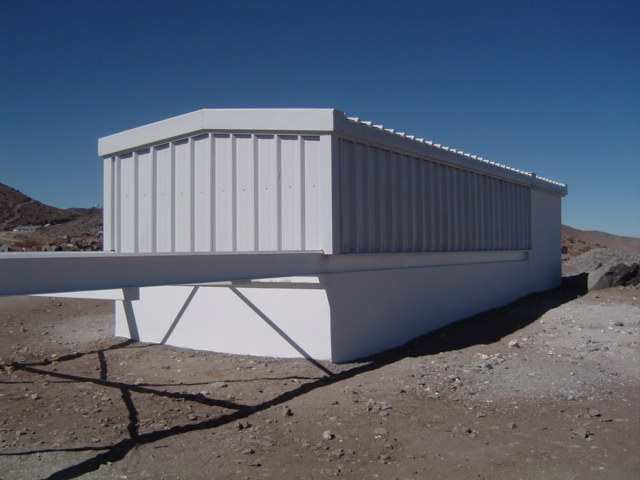COE Observatory Report
2007-2008
Tennessee State University
Center of Excellence in Information Systems
Nashville, Tennessee 37209
This report covers the interval October 1, 2007 through December 31, 2008. The Bulletin of the American Astronomical Society no longer publishes annual Observatory Reports. The TSU Center of Excellence will continue to report annual research summaries on this website. Beginning in 2009, we will convert to calendar years rather than the fiscal year used by the federal government and by the BAAS.
The astrophysics program in the TSU Center of Excellence concentrates on photometry and spectroscopy of cool giants, chromospherically active stars, solar-type stars, planetary-candidate host stars, binary and multiple stars, and pulsating variables, as well as building and managing robotic telescopes and applying automation to astronomy. Astronomy staff in 2007-08 were Geoffrey S. Burks, Michael R. Busby, Joel A. Eaton, Francis C. Fekel, Gregory W. Henry, and Michael H. Williamson. Student research assistants were Sharina Haynes and Julia O'Connell.
Dr. Matthew Muterspaugh (Townes Postdoctoral Fellow at the University of California, Berkeley) will become the newest member of our Automated Astronomy Group in 2009 January. He has accepted a tenure-track faculty position in the TSU Department of Physics and Mathematics.
OBSERVING FACILITIES
Center of Excellence astronomers continue to operate several automatic telescopes at Fairborn Observatory in the Patagonia mountains of southern Arizona. Fairborn Observatory is a non-profit Educational Corporation directed by Lou Boyd and dedicated to the design, construction, and operation of automated telescopes. TSU telescopes include the T3 0.40 m automated photometric telescope (APT) for Johnson BV photometry, the T4 0.75 m APT for Stromgren by photometry, the T8, T10, T11, and T12 0.80 m APTs, also for Stromgren by photometry, and the T13 2.0 m automatic spectroscopic telescope (AST) for high-resolution echelle spectroscopy. The table below gives the number of years each telescope has been operational, the total number of observations it has collected, and the current observing program(s). The number of observations for each telescope refers to complete group observations for the APTs and calibrated spectra for the AST.
| Telescope | Type | Years | Observations | Primary Observing Program(s) |
|---|---|---|---|---|
| T2 | 0.25 m APT | 19 | 121,590 | Semi-Regular Variables (Decommissioned 2007) |
| T3 | 0.40 m APT | 21 | 313,772 | Chromospherically Active Stars, Early-F Stars |
| T4 | 0.75 m APT | 16 | 104,455 | Solar-type Stars |
| T8 | 0.80 m APT | 13 | 112,492 | Solar-type Stars |
| T10 | 0.80 m APT | 9 | 88,753 | Solar-type Stars, Planetary Candidate Stars |
| T11 | 0.80 m APT | 9 | 87,444 | Solar-type Stars, Planetary Candidate Stars |
| T12 | 0.80 m APT | 9 | 97,903 | Planetary Candidate Stars |
| T13 | 2.03 m AST | 5 | 45,367 | Giant Stars, Binary & Multiple Starss |
The three year funding period of the National Science Foundation (NSF)
Major Research Instrumention (MRI) grant
"Acquisition of Three
Automatic Photoelectric Telescopes for Northern and Southern Hemisphere
Extrasolar Planet Searches" with Henry as PI and P. Butler (Carnegie
Institution of Washington) as CoI came to an end in 2008 August. L. Boyd
at Fairborn Observatory is building the telescopes, from designs very
similar to the existing T10, T11, and T12 APTs. At the end of 2008, we
are awaiting delivery of the optics. All mechanical and electronic parts
necessary to build the telescope mounts, two-channel photometers, and
control systems are in hand. Final assembly can begin when the mirror
sets arrive.
 The roll-off roof
enclosure for the two southern hemisphere telescopes has been completed
at Carnegie's Las Campanas Observatory (LCO) in the Andes mountains of
northern Chile, where two of the APTs will be located. The photo at left
shows the enclosure under construction with the twin 6.5 m Magellan
telescopes in the background. The photo at right below shows the completed
enclosure. The 24.5 m Giant Magellan Telescope will also be located at the
Las Campanas Observatory site. Dark, clear skies and exceptional seeing
make the Las Campannas Observatory site one of the best in the world.
The roll-off roof
enclosure for the two southern hemisphere telescopes has been completed
at Carnegie's Las Campanas Observatory (LCO) in the Andes mountains of
northern Chile, where two of the APTs will be located. The photo at left
shows the enclosure under construction with the twin 6.5 m Magellan
telescopes in the background. The photo at right below shows the completed
enclosure. The 24.5 m Giant Magellan Telescope will also be located at the
Las Campanas Observatory site. Dark, clear skies and exceptional seeing
make the Las Campannas Observatory site one of the best in the world.
 Late in 2008,
M. Roth (LCO Director) hired a senior-level technician, Juan Zhukov Espoz
Navarro, to be shared by LCO and the APT project. A primary task for
2009 will be to automate the enclosure and install all support equipment
in preparation for arrival of the telescopes.
Late in 2008,
M. Roth (LCO Director) hired a senior-level technician, Juan Zhukov Espoz
Navarro, to be shared by LCO and the APT project. A primary task for
2009 will be to automate the enclosure and install all support equipment
in preparation for arrival of the telescopes.
Eaton and Williamson continue construction of a new Ca II H&K spectrograph for the 2 m AST. The spectrograph was funded by a second NSF Major Research Instrumention (MRI) grant to TSU with Eaton as PI and with CoI's Henry and J. Hall and G. W. Lockwood of Lowell Observatory. When complete, the spectrograph will be dedicated to observing the solar-type stars Henry is monitoring with the APTs.
The Celestron C-14 telescope and Astro-Physics mount at Dyer Observatory that was described in last year's report was decommissioned in mid 2008. It had been used to observe a number of M dwarf planetary candidate host stars.
PUBLICATIONS
Bruntt, H., Evans, N. R., Stello, D., Penny, A. J., Eaton, J. A., Buzasi, D. L., Sasselov, D. D., Preston, H. L., and Miller-Ricci, E., "Polaris The Cepheid Returns: 4.5 Years of Monitoring From Ground and Space," Astrophysical Journal 683, 433, 2008. (paper)
Eaton, J. A., "Emission Lines in 32 Cygni," The Journal of Astronomical Data, 14, 3, 2008. (paper)
Eaton, J. A., "A Model for the Chromosphere/Wind of 31 Cygni and its Implications for Single Stars," Astronomical Journal 136, 1964, 2008. (paper)
Eaton, J. A., "Spurious Eccentricities of Distorted Binary Components," Astrophysical Journal 681, 562, 2008. (paper)
Eaton, J. A., Henry, G. W., and Odell, A. P., "Orbits and Pulsations of the Classical Zeta Aurigae Binaries," Astrophysical Journal 679, 1490, 2008. (paper)
Fekel, F. C., Hinkle, K. H., Joyce, R. R., Wood, P. R., and Howarth, I. D., "Infrared Spectroscopy of Symbiotic Stars. VI. Combined Orbits for Two S-Type Systems: V455 Scorpii and SS 73-90," Astronomical Journal 136, 146, 2008. (paper)
Fischer, D. A., Marcy, G. W., Butler, R. P., Vogt, S. S., Laughlin, G., Henry, G. W., Abouav, D., Peek, K. M. G., Wright, J. T., Johnson, J. A., McCarthy, C., and Isaacson, H., "Five Planets Orbiting 55 Cancri," Astrophysical Journal 675, 790, 2008. (paper)
Haynes, S., Burks, G., Johnson, C. I., and Pilachowski, C. A., "Chemical Analysis of Five Red Giants in the Globular Cluster M10 (NGC 6254)," Publications of the Astronomical Society of the Pacific 120, 1097, 2008. (paper)
Henry, G. W. and Winn, J. N., "The Rotation Period of the Planet-Hosting Star HD 189733," Astronomical Journal 135, 68, 2008. (paper)
Marsden, S. C., Berdyugina, S. V., Donati, J.-F., Eaton, J. A., and Williamson, M. H., "Starspots and Relativity: Applied Doppler Imaging for the Gravity Probe B Mission," Astronomische Nachrichten 328, 1047, 2007. (paper)
Mikulasek, Z., Krticka, J., Henry, G. W., et al., "The Extremely Rapid Rotational Braking of the Helium Strong Star HD 37776," Astronomy and Astrophysics 485, 585, 2008. (paper)
Mikulasek, Z., Krticka, J., Zverko, J., Henry, G. W., Janik, J., Romanyuk, I. I., Ziznovsky, J., Bozic, H., Zejda, M., Graf, T., and Netolicky, M., "The Record-Breaking Rotational Braking of the He Strong CP Star HD 37776," Contributions of the Astronomical Observatory Skalnate Pleso 38, 429, 2008. (paper)
Muterspaugh, M. W., Lane, B. F., Fekel, F. C., Konacki, M., Burke, B. F., Kulkarni, S. R., Colavita, M. M., Shao, M., and Wiktorowicz, S. J., "Masses, Luminosities, and Orbital Coplanarities of the Mu Orionis Quadruple Star System From Phases Differential Astrometry," Astronomical Journal 135, 766, 2008. (paper)
Percy, J. R., Mashintsova, M., Nasui, C. O., Palaniappan, R., Seneviratne, R., and Henry, G. W., "Further Studies of the Photometric Variability of Bright Pulsating Red Giants," Publications of the Astronomical Society of the Pacific 120, 523, 2008. (paper)
Strassmeier, K. G., Bartus, J., Fekel, F. C., and Henry, G. W., "The Chromospherically Active, Triple, Ellipsoidal, and Eclipsing Binary HD 6286 = BE Piscium: A Laboratory for Binary Evolution," Astronomy & Astrophysics 485, 233, 2008. (paper)
Tomkin, J. and Fekel, F. C., "New Precision Orbits of Bright Double-Lined Spectroscopic Binaries. II. HR 2962, HD 214686, and 16 Psc," Astronomical Journal 135, 555, 2008. (paper)
Winn, J. N., Henry, G. W., Torres, G., and Holman, M. J., "Five New Transits of the Super-Neptune HD 149026b," Astrophysical Journal 675, 1531, 2008. (paper)
Wright, J. T., Marcy, G. W., Butler, R. P., Vogt, S. S., Henry, G. W., Isaacson, H., and Howard, A. W., "The Jupiter Twin HD 154345b," Astrophysical Journal 683, L63, 2008. (paper)
Zuckerman, B., Fekel, F. C., Williamson, M. H., Henry, G. W., and Muno, M. P., "Planetary Systems Around Close Binary Stars: The Case of the Very Dusty, Sun-Like, Spectroscopic Binary BD +20 307," Astrophysical Journal, 688, 1345, 2008. (paper)